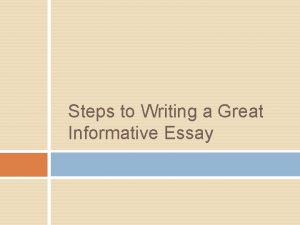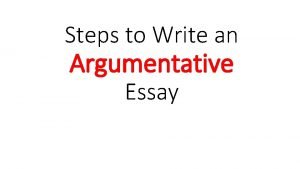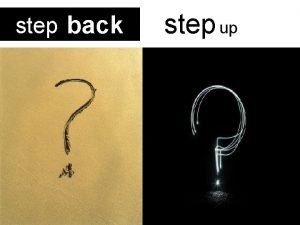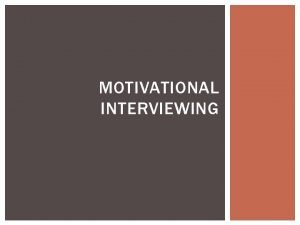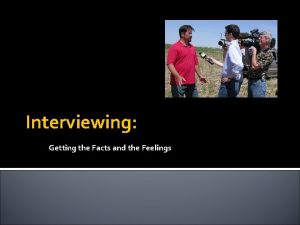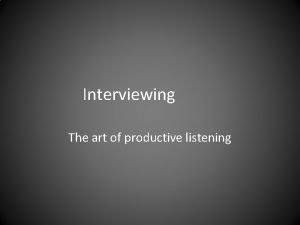Interviewing Why and How STEP 1 UNDERSTAND WHY

















- Slides: 17

Interviewing Why and How

STEP 1: UNDERSTAND WHY CHURCHILL SAID, “QUOTATIONS, ENGRAVED UPON THE MEMORY, GIVE YOU GOOD THOUGHTS” Churchill liked to read books of quotations, and urged others to do likewise. I concur with his advice, especially in the sense that I suspect he meant it. By reading collections of quotations, and not just hunting for one that meets your immediate needs, you absorb, through osmosis, a broad spectrum of eloquence.

STEP 2: USE A QUOTE WHEN YOU CAN’T SAY IT PERFECTLY BUT SOMEONE ELSE ALREADY HAS Yes, I am switching parties, but I reject the accusation that I am a flip-flopper—as though there is something bad about re-aligning myself with a party that more closely reflects how my views have evolved. vs. Let me respond to that by quoting Churchill: “Some men change their party for the sake of their principles; others their principles for the sake of their party. ”

STEP 3: USE QUOTES TO LEND AUTHORITY We can enter into this deal confident that the economy will rebound. I have read many reports, including government predictions, and they almost all indicate to me that things will be on the upswing within the next six months. vs. We can enter into the deal confident that the economy will rebound. “Almost every major indicator points to a major recovery, ” says Harvard economist Everett Sloane, a former undersecretary of the Treasury. “I’ve seen these cycles repeat themselves a dozen times, and I’m certain that the markets will be moving up steadily in six months. ”

STEP 4: USE QUOTES TO ADD COLOR Despite the high crime rate in the city’s Division Street neighborhood, the streets are alive with hundreds of people at 2 a. m. Sgt. Robert Pine, who has patrolled the district for more than a decade, says that the mix of potential victims and likely predators is volatile. vs. Despite the high crime rate in the city’s Division Street neighborhood, the streets are alive with hundreds of people at 2 a. m. “Half the people you see right now are crooks, ” says Sgt. Robert Pine, who has patrolled this district for more than a decade. “Half are victims. And they’re doing their damndest to get together. ”

STEP 5: USE PARTIAL QUOTES AND PARAPHRASES “The situation requires some immediate remediation, ” says Robert Mc. Elwain, the eastern division director of finance. “There were attempts to restructure the debt in 2011, 2013, and 2014. Three times and no one could come to an agreement. It’s something that needs to be solved and we keep putting it off. This could cause catastrophic problems. We can’t keep kicking the can down the road. ” vs. Robert Mc. Elwain, the eastern division director of finance, says the debt problem has been brought to the table three times but was never fixed. He predicts “catastrophic problems” if the situation isn’t fixed, and warns that “we can’t keep kicking the can down the road. ”

STEP 6: BE TRANSPARENT IN CITING THE SOURCE OF YOUR QUOTES Lifting a quote that someone else invested a lot of effort into getting is a major transgression in professional writing. Never lift a journalistic quote from another source and imply, intentionally or unintentionally, that you were the one who obtained it. Feel free to use someone else’s quote when you cite the source, like this: “We want mining business to settle in Monroe County, ” Mayor Hilliard told the Monroe Herald in a December, 2015 interview, “and we will put our money where our mouth is by offering generous tax credits. ”

STEP 7: ATTRIBUTE QUOTES ETHICALLY If you write Bob Smith robbed a bank, and it turns out later that it was a case of mistaken identity and Bob Smith did not rob a bank, you are in bigger trouble than Bob Smith. If you write New York police say Bob Smith robbed a bank, and it turns out Bob Smith did not rob a bank, you are more or less off the hook. If you write “Bob Smith was charged with the robbery of the First National Bank branch on 32 nd St. , ” said Capt. Robert Le. Roy of the 87 th precinct, you are completely off the hook because what you wrote is true, even if the charge later turns out to be false.

STEP 8: ATTRIBUTE QUOTES GRACEFULLY AND GRAMMATICALLY For most quotes, put attribution at the end of the sentence. Put a comma inside the quotation mark and attribute with “______ said. ” Use “said” or “says. ” The choice of tense is up to you, but if it’s a statement that is controversial or about a situation that is fluid, past tense is a better choice. If it’s feature-type, human-interest writing, go with present tense. Put the name first (Wilson said) unless you are further identifying Wilson. If you further identify her with more than a couple words of description, put “said” first.

Attribution, Continued. . If it is a long quote, put the attribution after the first sentence or phrase. “This report isn’t worth the paper it’s printed on, ” says Lydon Roberts, an economics professor at Yale. “It makes no distinction between full-time and parttime jobs added last year. That’s a huge difference, and without knowing more we have no idea if the economy is getting better or worse. ”

STEP 9: CHANGE QUOTES WITH EXTREME CAUTION Fix the types of grammatical errors and throwaways we all make in common speech. Do not quote someone in dialect (including a pattern of poor grammar) if it is demeaning or there is no legitimate reason to do so. But don’t go overboard with fixing grammar. If there is a reason to quote ungrammatically (including a need to reflect the authenticity of the interview) do so, but with caution. When in doubt, you can always paraphrase

STEP 10: EMPLOY EVOCATIVE INTERVIEW TECHNIQUES TO COAX A QUOTE FROM A SOURCE Do some background research on the person you are interviewing. This is essential. There’s an old saying that there’s no such thing as a stupid That, frankly, is stupid advice. If you ask a dumb question of an interviewee, something that easily could have been obtained in a quick web search, you are wasting the interviewee’s time as well as your own.

Interview, continued. . . Before the interview begins, let the person know what the purpose is and what you are after. People are often needlessly paranoid about interviews, and can be defensive and uncooperative unless put at ease. Try, for example: “I’m doing a story for the company newsletter about trends in intellectual property law and how that might affect us. I wanted to talk with you not only because you’re a lawyer in this field, but because I’ve read that you have pretty strong opinions about how current regulations are ineffective. Can you tell me about. . . ”

Interview continued. . Put together a list of questions but don’t be a slave to the list. Ask follow-ups if the interviewee tells you something interesting; don’t just mechanically rattle off the next question. Follow up with another question when an interviewee blows you off with a pat answer. If you get, “those issues are all addressed in our policy, ” ask, “could you give me an example? ” Asking for an example almost always draws out a reluctant interviewee.

Interview continued. . . Ask simple, single-part questions. A complex question with multiple parts usually doesn’t get a very clear response, plus the awkwardness sometimes irritates the person you are interviewing. Avoid yes-or-no questions, unless you are trying to pin an evasive interviewee down. Try to initiate a conversation. “What do you think about the current proposal? ” is better than, “Do you favor the current proposal? Personalize questions. If you ask, “what is your agency’s position on. . . ” you may prompt your interviewee to shut down, responding, “I can’t speak for the agency. ” Instead, try “what sort of things do you and your agency do to overcome. . ”

Interview continued. . . Be careful of making meaningless noises during the interview. Saying “uh-huh” after every response not only becomes annoying, but it also establishes a rhythm in which the interviewee may wait for you to say “uh-huh” before continuing. Likewise, try not to establish a perceptible rhythm with your note-taking. If you don’t write anything down until your interviewee says something that strikes your fancy, the person may assume that you are not paying attention when you are not writing things down. A good solution: write all the time, even if you doodle on the page. The interviewee won’t know what you are writing, and won’t become concerned about what you are writing down and what you are not.

Interview continued. . . Sometimes the best question is no question. If a person isn’t being responsive, just wait. People hate silence, finding it awkward, and will usually do anything to fill it—including giving you a responsive answer. The best tip of all: If your interviewee says, “no comment, ” ask “why don’t you want to comment? ” You’ll often get the answer you wanted.
 Step 1 step 2 step 3 step 4
Step 1 step 2 step 3 step 4 To understand recursion you must understand recursion
To understand recursion you must understand recursion Andreas carlsson bye bye bye
Andreas carlsson bye bye bye How to graph sine and cosine functions step by step
How to graph sine and cosine functions step by step Two step linear inequalities
Two step linear inequalities How to solve two step inequalities
How to solve two step inequalities Teeth disking
Teeth disking The age of the dinosaurs text structure
The age of the dinosaurs text structure Steps to writing an informative essay
Steps to writing an informative essay Steps of an argumentative essay
Steps of an argumentative essay Step up step back
Step up step back How to factor equations
How to factor equations How to solve simultaneous equations
How to solve simultaneous equations Simultaneous equations step by step
Simultaneous equations step by step Combining like terms steps
Combining like terms steps Steps in photosynthesis
Steps in photosynthesis Particle filter matlab code
Particle filter matlab code Real application testing
Real application testing








